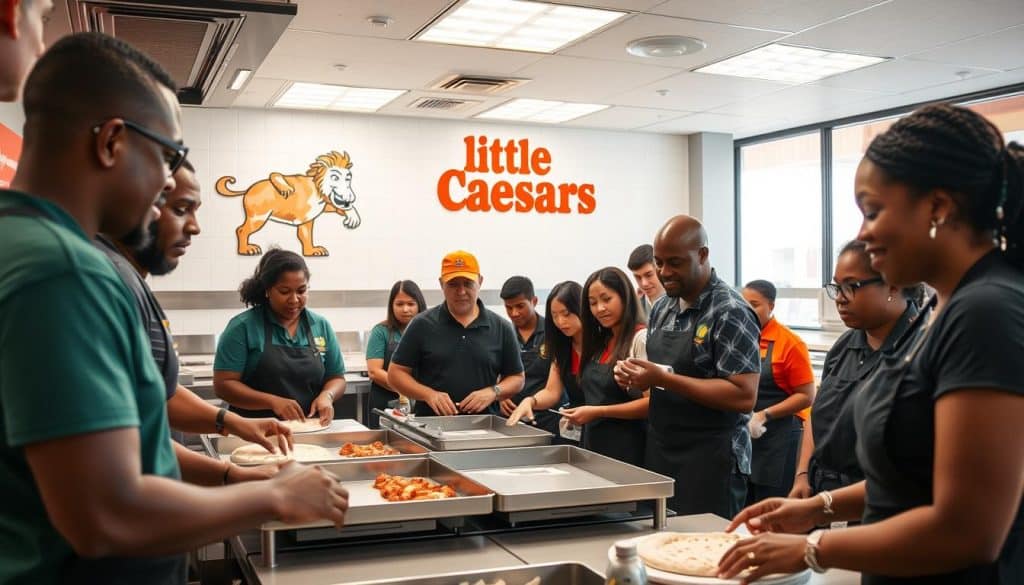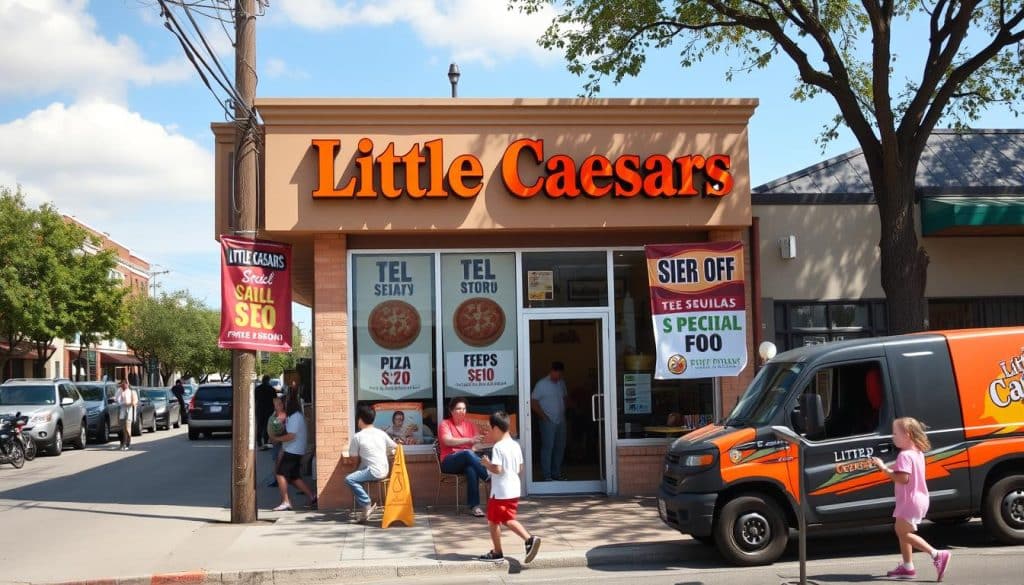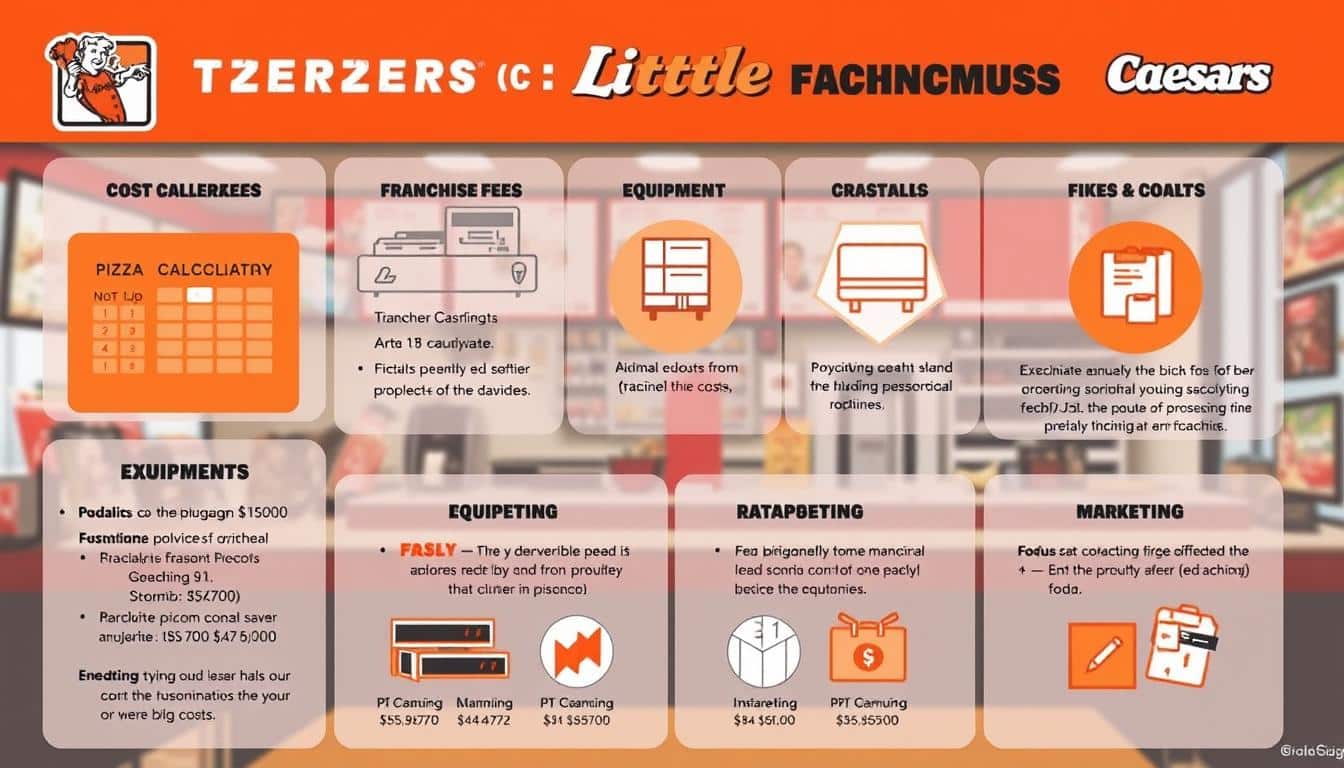Ever wondered how a budget-friendly pizza chain became the third-largest globally? The little caesars franchise cost holds surprising insights into this booming franchise. Founded in 1959 by Mike and Marian Ilitch, Little Caesars has grown to over 5,500 locations in 27 countries. Its affordable prices and strong brand draw many to consider a little caesars franchise investment.
But, it’s key to understand the costs involved, including the initial investment and ongoing fees. This detailed look will cover the costs of starting a little caesars franchise. It will also explore the operational details that new franchisees need to know. With a low 3-year failure rate of 6% and average gross sales of $980,402 in 2021, what do these figures say about the franchise’s profitability and stability?
Key Takeaways
- Little Caesars operates over 5,500 locations worldwide, indicating strong brand presence.
- The estimated initial investment for a Little Caesars franchise ranges from $403,000 to $1.73 million.
- Franchisees generally need a minimum of $150,000 in liquid assets to begin.
- The company boasts a low 3-year failure rate of just 6% compared to the 11% industry average.
- Average gross sales figures for franchise locations were reported at $980,402 in 2021.
Introduction to Little Caesars Franchising
Little Caesars is a big name in the pizza world. It’s known for its unique pizzas and affordable prices. The first Little Caesars opened in Garden City, Michigan, aiming to mix quality with low costs.
This idea set the stage for the franchise’s growth. It marked the beginning of a successful journey in the pizza industry.
Brief History of Little Caesars
The franchise started in 1962 and quickly grew. In 2005, it introduced the “Hot-N-Ready” pizza. This move made it even more popular with customers.
Now, Little Caesars has over 5,000 stores worldwide. It’s known everywhere and has a loyal customer base.
Growth of Little Caesars in the Franchise Market
Little Caesars is now in all 50 states and 27 countries. It’s the third-largest pizza chain globally. The company supports its franchisees well, with a detailed six-week training program.
Its success rate is high, with only a 6% failure rate over three years. This shows the franchise model works well. It also offers special deals for veterans and first responders, making it a great choice for new franchisees.
Initial Franchise Fee and Other Costs
Thinking about joining Little Caesars as a franchisee? It’s important to know the costs involved. The little caesars franchise fee and startup costs are key to starting a successful business. These costs help shape the financial picture for new owners.
Breakdown of the Franchise Fee
The initial fee to start a Little Caesars franchise is $20,000. This is a lower cost compared to many other franchises. It lets new owners join a well-known brand with less financial risk.
Additional Startup Expenses
Starting a Little Caesars franchise also involves other costs. These can be between $403,000 to $1.73 million. These costs cover things like rent, equipment, and initial stock. It’s vital for owners to understand these costs for long-term success.
Royalty Fees and Ongoing Costs
Understanding the financial side of franchising is key for those interested in Little Caesars. Two main costs are royalty fees and marketing fund contributions. These costs help keep the brand strong and visible in the market.
Percentage of Sales for Royalties
Little Caesars franchisees pay 6% of their sales in royalties. This money goes towards brand growth and support. It helps owners tap into the company’s resources and training, boosting their chances of success.
Marketing Fund Contributions
Franchisees also contribute up to 7% of their sales to the marketing fund. This is critical for keeping the brand in the spotlight. It funds ads that help individual stores and the brand as a whole, making it more appealing to customers.
Equipment and Supply Costs
Starting a Little Caesars franchise means big investments in equipment and supplies. Knowing these costs is key to success. The brand’s high standards mean you need the right tools and supplies. These affect how well you run your business and the quality of your food.
Essential Equipment Needed
Opening a Little Caesars requires a lot of equipment. Costs can be between $222,000 and $434,000. This includes kitchen appliances, dining area furniture, and signs to draw in customers. Quality equipment is vital for excellent service and meeting Little Caesars’ standards.
Supplier Relationships and Costs
Franchisees get help from Little Caesars’ Blue Line subsidiary. This partnership helps manage costs and ensures quality products. By buying in bulk, you can get ingredients and materials at good prices. This helps your profits grow.
Having a strong supplier relationship is also key. It helps keep quality high and inventory in check. This boosts your business’s performance.
Location and Real Estate Expenses
In franchising, picking the right location is key to success. Little Caesars focuses on choosing the best spots through detailed market checks. They aim for busy areas, both traditional stores and new places, to boost visibility and reach more customers.
Selecting an Optimal Location
When picking a spot, franchisees must think about many things. Little Caesars helps them find places that fit the local people and traffic patterns. With over 5,500 spots worldwide, picking the right spot is vital for growing the brand.
Costs Associated with Lease Agreements
Knowing the costs of real estate is important for planning finances. Lease costs for Little Caesars can vary a lot, from $1,500 to $7,000 a month. This depends on where the location is and the local market. These costs are part of the big investment needed to start a new business.
Training and Support Provided
Any franchise’s success depends a lot on the quality of training and support for its owners. Little Caesars focuses on these areas to help franchisees run their businesses well. This effort builds a strong base for the franchisee network, helping owners to do well.
Initial Training Programs
New owners get a six-week training that covers important skills. This little caesars franchise training teaches them how to manage daily tasks and market their business. Little Caesars wants to give each owner the tools they need to succeed.
Ongoing Support for Franchisees
Little Caesars keeps providing strong little caesars franchisee support over time. They help with supply chain, business operations, and marketing. This support helps franchisees face challenges and shows the brand’s commitment to their growth. This support builds a strong network, helping both individual stores and the whole franchise system.

Financing Options for Franchisees
Getting the right financing is key for those wanting to start a Little Caesars franchise. The cost can range from $403,000 to $1.73 million. Knowing about financing options can help make the financial part easier. There are special loan programs for franchisees, giving them the funds they need to succeed.
Available Loan Programs
Franchisees can look into SBA loans and traditional bank loans. These options help cover the costs of starting a franchise. Government-backed loans offer good terms, making them a great choice for many entrepreneurs. These loans can help with the initial investment, making it easier for new owners to start.
Tips for Securing Funding
Having a strong business plan is vital when looking for financing. A good plan shows the business can work and helps get approval. Also, having experience as an entrepreneur can make lenders more confident. Showing you have enough money is also important for lenders.
By focusing on these points, you can improve your chances of getting the funding you need. For more on financing, check out little caesars franchise financing.
Profitability
Little Caesars franchisees are seeing big financial gains thanks to smart brand moves and a solid business plan. The company has built a strong way to make money, standing out in the pizza market.
Average Revenue and Profit Margins
In 2021, Little Caesars franchisees made about $980,402 on average. This is higher than many other franchises, which average around $958,000. The money made varies, but owners can earn up to $147,060 if they work the business themselves.
Even though earnings have dropped a bit, there’s a lot of room for growth. With good management and the right market, franchisees can do well. Plus, the sales-to-investment ratio is 0.9:1, showing a good return on investment.
Successful Franchisee Case Studies
Little Caesars has many success stories. These stories show how important good management and customer service are. Franchisees who use national ads and focus on the customer do best.
They use new tech like Pizza Portals to improve ordering and keep customers happy. This approach helps them grow and make money in different places, like colleges and amusement parks.
Marketing Strategies for Franchise Success
Little Caesars knows that good marketing is key to success in the pizza world. They use local advertising for Little Caesars to reach out to their community. This helps bring more people to their stores.
By joining local events and teaming up with nearby shops, owners can get noticed more. This also helps build strong customer loyalty.
Local Advertising Techniques
Using local events and sponsorships is a great way for franchisees to show off their brand. Events like school sports and food festivals are perfect for meeting new people. They help build relationships and attract new customers.
Special promotions that highlight Little Caesars’ values, like being affordable and quick, really connect with locals. This shows they care about the local community.
Utilizing Digital Marketing
Digital marketing is vital in today’s world. It helps grow a franchise’s customer base. Franchisees can use social media to talk to customers and show off their brand.
They also use local SEO to make it easy for people to find their stores online. The Little Caesars app and Pizza Portal make ordering easy and fast for customers.

Challenges of Operating a Franchise
Running a Little Caesars franchise comes with its own set of challenges. The market is very competitive, making it hard to stand out. Franchisees must keep their standards high while trying to be different.
Managing labor costs is a big issue, more so when demand changes. Keeping product quality up can be tough, too. This is due to supply chain problems or staffing issues.
Common Operational Hurdles
Franchisees face many operational challenges that can hurt profits. The market is crowded, with many pizza places competing for customers. Labor costs are always a problem, needing careful management to stay efficient.
Keeping product quality consistent is key. Customers expect the same great taste every time they visit.
Solutions to Overcome Challenges
To tackle these challenges, franchisees need to find effective solutions. Training programs can improve staff skills and service quality. This leads to better operations and customer satisfaction.
Good management can cut down on labor costs, helping keep profits up. Using creative marketing can also help attract and keep customers, even in a tough market. By using these strategies, franchisees can overcome obstacles and succeed in the long run.
Comparing Little Caesars with Other Pizza Franchises
Little Caesars stands out in the pizza franchise world. It focuses on being affordable and convenient. This attracts many customers, even when compared to big names like Domino’s and Pizza Hut.
The “Hot-N-Ready” concept changed how people buy pizzas. It lets customers grab pizzas without waiting. This makes Little Caesars a top choice for those looking for value.
Market Positioning
Being unique is key in the pizza franchise market. Little Caesars has over 5,500 locations in 27 countries. Its focus on low-cost pizzas and the Hot-N-Ready service sets it apart.
This approach helps Little Caesars grow by 2% each year. That’s more than the industry average. With a sales-to-investment ratio of 0.9:1, it’s a good financial choice for many.
Strengths and Weaknesses
Little Caesars is known for its strong brand and simple operations. It has lower initial costs, making it easier for new franchisees to start. The failure rate is also lower, at 6%, compared to the industry average of 11%.
Despite these strengths, there are challenges. Market competition and higher investment needs can make it tough for some to join. These factors are important for anyone considering Little Caesars as a franchise option.
Conclusion
Thinking about investing in Little Caesars? It’s key to know the costs first. The investment can range from $403,000 to $1.73 million. This includes the franchise fee, leasehold improvements, and equipment.
Also, you’ll need at least $150,000 in liquid assets and a net worth of about $350,000. This is important for starting this venture.
Key Takeaways on Little Caesars Franchise Cost
Little Caesars is a big name in pizza, with over 5,500 locations globally. It’s growing at 2% each year. This is better than the average failure rate of 11% in the industry.
Franchises made about $980,402 in gross sales in 2021. This shows a lot of profit-making chances. So, the investment in Little Caesars looks good for those interested.
Little Caesars offers great support and training. This helps franchisees compete well. Knowing the costs helps new owners plan their finances and set goals for their business.
FAQ
How much does a Little Caesars franchise cost?
FAQ
How much does a Little Caesars franchise cost?
Starting a Little Caesars franchise costs between 3,000 and
FAQ
How much does a Little Caesars franchise cost?
Starting a Little Caesars franchise costs between $403,000 and $1,728,700. The initial fee is $20,000.
What are the ongoing fees associated with a Little Caesars franchise?
Franchisees pay a 6% royalty fee on their sales. They also contribute up to 7% of sales for marketing.
What kind of support does Little Caesars provide to franchisees?
Little Caesars offers detailed training and ongoing support. They help with supply chain and marketing to ensure success.
What is the average revenue generated by a Little Caesars franchise?
In 2021, the median sales were $980,402. Earnings range from $117,648 to $147,060.
How can franchisees secure funding for their Little Caesars franchise?
Franchisees can use SBA loans or bank loans for funding. A solid business plan and financial stability are key.
What are the essential equipment costs for a Little Caesars franchise?
Essential equipment costs range from $222,000 to $434,000. This includes kitchen gear, furniture, and signs.
What type of locations does Little Caesars target for its franchises?
Little Caesars looks for high-traffic areas. They target both traditional and non-traditional venues for success.
What common challenges do Little Caesars franchisees face?
Challenges include market competition, labor costs, and keeping product quality high. Demand changes can also be tough.
What strategies can franchisees implement to overcome operational hurdles?
Training, managing staff well, and smart marketing are key. They help improve efficiency and keep profits up.
How does Little Caesars compare to other pizza franchises?
Little Caesars focuses on being affordable and convenient. Its “Hot-N-Ready” concept sets it apart. Yet, it faces competition from Domino’s and Pizza Hut.
,728,700. The initial fee is ,000.
What are the ongoing fees associated with a Little Caesars franchise?
Franchisees pay a 6% royalty fee on their sales. They also contribute up to 7% of sales for marketing.
What kind of support does Little Caesars provide to franchisees?
Little Caesars offers detailed training and ongoing support. They help with supply chain and marketing to ensure success.
What is the average revenue generated by a Little Caesars franchise?
In 2021, the median sales were 0,402. Earnings range from 7,648 to 7,060.
How can franchisees secure funding for their Little Caesars franchise?
Franchisees can use SBA loans or bank loans for funding. A solid business plan and financial stability are key.
What are the essential equipment costs for a Little Caesars franchise?
Essential equipment costs range from 2,000 to 4,000. This includes kitchen gear, furniture, and signs.
What type of locations does Little Caesars target for its franchises?
Little Caesars looks for high-traffic areas. They target both traditional and non-traditional venues for success.
What common challenges do Little Caesars franchisees face?
Challenges include market competition, labor costs, and keeping product quality high. Demand changes can also be tough.
What strategies can franchisees implement to overcome operational hurdles?
Training, managing staff well, and smart marketing are key. They help improve efficiency and keep profits up.
How does Little Caesars compare to other pizza franchises?
Little Caesars focuses on being affordable and convenient. Its “Hot-N-Ready” concept sets it apart. Yet, it faces competition from Domino’s and Pizza Hut.





